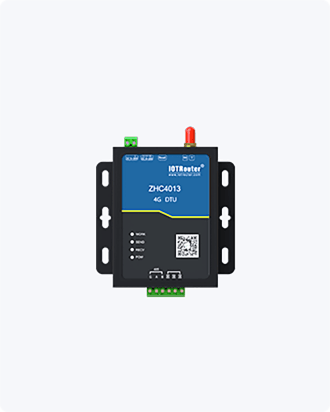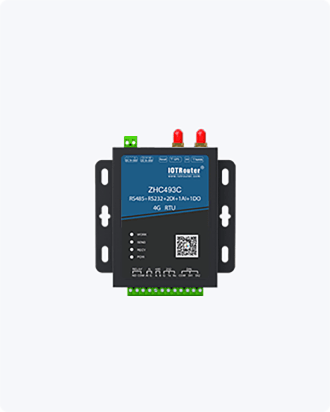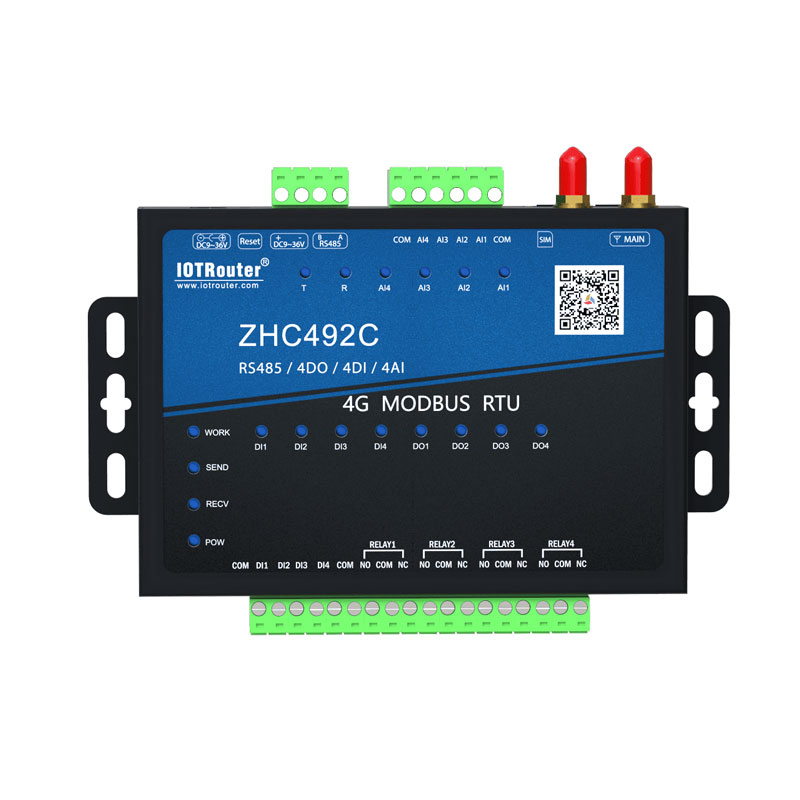The collection and transmission module developed by IOTRouter mainly uses 4G network as the transmission channel, which can realize the mutual transmission of data between serial devices and network servers through the operator’s network.
Collection and transmission module
Currently, it can be roughly divided into two categories of products . The first category is pure transparent transmission, the second type is a transparent transmission function with multiple interfaces and band control.
1. Pure transparent transmission (4G DTU)
Compatible with Modbus RTU/TCP protocol and JSON. With “remote control” as the core function and high ease of use, users can easily and quickly integrate it into their own systems to achieve remote and local control based on LTE and RS485.
| Product picture | Model/Type | Interface | Functie |
 |
ZHC4013 (ear-mounted) | RS485 |
|
2. Transparent transmission and control
Compatible with Modbus RTU/TCP protocol. With “remote control” as the core function and high ease of use, users can easily and quickly integrate it into their own systems to achieve remote and local control based on LTE and RS485. Supports local logic operations , wet and dry node detection and other functions.
| Product picture | Netwerk/Model | Interface | Functie |
 |
4G-communicatie via volledig netwerk | 2DI/1DO/1AI/1RS485 |
|
 |
4G-communicatie via volledig netwerk | 4DI/4DO/4AI/1RS485 |
|
 |
4G-communicatie via volledig netwerk
|
8DO/8DI/8AI/485/232 |
|
 |
4G-communicatie via volledig netwerk | 4AI/4AO/485 |
|
Bringing Collection and Transmission Modules to Real-World Applications
Many businesses struggle with dispersed equipment and fragmented data. That’s exactly where the IOTRouter Collection and Transmission Module comes in. With multiple interfaces, protocol support, and local logic processing, it helps teams see equipment status clearly and manage operations more efficiently.
Let’s look at a couple of real-world scenarios to see how DTU en RTU modules actually work on site.
Scenario 1: Smart Pump Stations for Modern Agriculture
In large agricultural estates, irrigation pump stations are central to water supply. Pumps, valves, and level sensors are scattered across fields and canals. In the past, operators had to walk between locations to check equipment, which was time-consuming and sometimes meant irrigation wasn’t accurate.
By installing the ZHC493C module, the farm gained a smarter, remote way to manage its pump stations:
-
Flexible connections: DI inputs monitor level switches, DO outputs control pumps, AI inputs measure water pressure, and RS485 links to PLCs for real-time data.
-
Reliable 4G transmission: Data is sent to the irrigation management platform via 4G, supporting Modbus RTU/TCP, making integration with existing systems smooth.
-
Automatic logic: The module can trigger alarms or pump operations when water level or pressure exceeds thresholds, reducing the need for manual checks.
-
Practical results: Operators can now control multiple pump stations from a single dashboard, saving time and ensuring more precise irrigation.
One farm manager commented, “It’s a huge relief—I can monitor pump operations from my office instead of walking kilometers across the fields.”
Thanks to this upgrade, pump stations are no longer isolated equipment—they’re part of a smart irrigation network, showing the real value of Collection and Transmission Modules in agricultural digitalization.
Scenario 2: Industrial Power Distribution Room Upgrade
In factories and commercial buildings, power distribution rooms contain a variety of equipment with strict safety requirements. Many systems still rely on RS485 point-to-point connections, which makes centralized monitoring difficult. You might wonder, “Do we need to replace everything to digitize?” Actually, no.
By adding the ZHC495C module, the client modernized their system without replacing old devices:
-
Comprehensive data collection: 8DI channels track breaker status, 8DO control fans and alarms, 8AI measure temperature, humidity, and current. RS232/RS485 collects data from meters and protection devices.
-
Local intelligence: The module can automatically activate fans or alarms if temperature or current goes beyond safe limits—no need to wait for cloud commands.
-
Cloud integration: Data is uploaded via MQTT, enabling real-time visualization and 24/7 monitoring.
-
Cost-effective solution: One module transforms a traditional distribution room into a smart, manageable system.
A customer shared, “This single module connected all our old equipment. Management efficiency improved immediately.”
This scenario demonstrates that Collection and Transmission Modules are a straightforward, economical way to bring legacy equipment online.
Broader Applications Across Industries
Beyond farms and power rooms, these modules work in a wide range of sectors:
-
Municipal and Environmental Monitoring: Real-time water quality, river levels, air quality, with automated alerts.
-
Building Automation and Security: Centralized control of access, fire alarms, and lighting.
-
Oil & Gas: Pressure monitoring and pipeline safety alerts.
-
Cold Chain and Maintenance: Predictive maintenance using cloud analytics.
-
Renewable Energy and EV Charging: Integration with inverters and meters for energy management.
-
Traffic and Parking Systems: Automated control of gates and signals, enabling unmanned operation.
The flexibility of these modules lets companies start digital transformation without heavy investment.
Conclusie
From simple “transparent transmission devices” to intelligent RTU/DTU with local logic, multiple protocols, and multi-interface support, IOTRouter Collection and Transmission Modules are now a key part of the IoT ecosystem. Whether on a farm, in a factory, or in urban infrastructure, they quietly improve efficiency and safety, helping companies confidently step into the digital era.